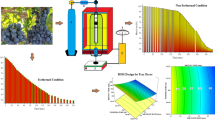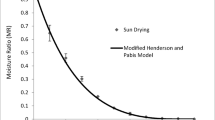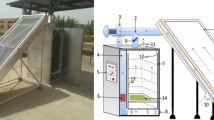Abstract
In this study, drying kinetics of Arapgir purple basil leaves under the isothermal and non-isothermal conditions have been investigated. Effective methods were evaluated by drying freshly collected basil leaves in the sun, isothermal, and non-isothermal systems. Energy efficiency was compared in different drying processes by performing exergy analysis in the drying process. It has been observed that the energy consumed and lost especially in the convection drying system (tray dryer) is very high. In the experiments performed in the PID (proportional integral derivative) system, the lowest efficiency was found in the isothermal process. Accordingly, the most suitable system in exergy efficiency was determined as the non-isothermal PID system. Maximum energy loss and minimum exergy efficiency were found at 45 °C temperature and 3.0 m/s airflow rate in the convection drying process. Exergy efficiencies were found to be approximately 4% in the convection tray dryer, 26% in the PID system under isothermal conditions, and 32% in the PID system under non-isothermal conditions. Optimization parameters in the drying process were determined by the response surface methodology (RSM), and the kinetic models were compared with the help of statistical analyses in the experiments. Midilli and Kucuk model has been found as the most compatible kinetic equation with the experimental data. According to this model results, correlation coefficient (R2 > 0.990), sum of squared error (SSE˂0.005), chi-square (χ2˂1·10−5), and root mean square error (RMSE˂0.003) values have been evaluated.
Graphical abstract











Similar content being viewed by others
References
Altay K, Hayaloglu AA, Dirim SN (2019) Determination of the drying kinetics and energy efficiency of purple basil (Ocimum basilicum L.) leaves using different drying methods. Heat and Mass Transfer/Waerme- Und Stoffuebertragung, 55(8), 2173–2184. https://doi.org/10.1007/s00231-019-02570-9
Amini G, Salehi F, Rasouli M (2021) Drying kinetics of basil seed mucilage in an infrared dryer: application of GA-ANN and ANFIS for the prediction of drying time and moisture ratio. J Food Process Preserv 45(3):1–9. https://doi.org/10.1111/jfpp.15258
Calín-Sánchez Á, Lech K, Szumny A, Figiel A, Carbonell-Barrachina ÁA (2012) Volatile composition of sweet basil essential oil (Ocimum basilicum L.) as affected by drying method. Food Res Int, 48(1), 217–225. https://doi.org/10.1016/j.foodres.2012.03.015
Díaz-Maroto MC, Palomo ES, Castro L, González Viñas MA, Pérez-Coello MS (2004) Changes produced in the aroma compounds and structural integrity of basil (Ocimum basilicum L) during drying. J Sci Food Agric 84(15):2070–2076. https://doi.org/10.1002/jsfa.1921
El-Sebaii AA, Shalaby SM (2012) Solar drying of agricultural products: a review. Renew Sustain Energy Rev 16(1):37–43. https://doi.org/10.1016/j.rser.2011.07.134
Kadam DM, Goyal RK, Gupta MK (2011) Mathematical modeling of convective thin layer drying of basil leaves. Journal of Medicinal Plant Research 5(19):4721–4730
Orphanides A, Goulas V, Gekas V (2016) Drying technologies: vehicle to high-quality herbs. Food Engineering Reviews 8(2):164–180. https://doi.org/10.1007/s12393-015-9128-9
Erbay Z, Hepbasli A (2014) Application of conventional and advanced exergy analyses to evaluate the performance of a ground-source heat pump (GSHP) dryer used in food drying. Energy Convers Manage 78:499–507. https://doi.org/10.1016/j.enconman.2013.11.009
Gungor A, Tsatsaronis G, Gunerhan H, Hepbasli A (2015) Advanced exergoeconomic analysis of a gas engine heat pump (GEHP) for food drying processes. Energy Convers Manage 91:132–139. https://doi.org/10.1016/j.enconman.2014.11.044
Hernández JA, Pavón G, Garcı́a MA (2000) Analytical solution of mass transfer equation considering shrinkage for modeling food-drying kinetics. J Food Eng, 45(1), 1–10. https://doi.org/10.1016/S0260-8774(00)00033-9
Malekjani N, Jafari SM (2018) Simulation of food drying processes by computational fluid dynamics (CFD); recent advances and approaches. Trends Food Sci Technol 78:206–223. https://doi.org/10.1016/j.tifs.2018.06.006
Nagaya K, Li Y, Jin Z, Fukumuro M, Ando Y, Akaishi A (2006) Low-temperature desiccant-based food drying system with airflow and temperature control. J Food Eng 75(1):71–77. https://doi.org/10.1016/j.jfoodeng.2005.03.051
Shahi NC, Singh A, Kate AE (2014) Activation energy kinetics in thin layer drying of basil leaves. Int J Sci Res (IJSR) ISSN, 3(7), 1836–1840. www.ijsr.net
Picado A, Martínez J (2006) Cinética de Secado de la Levadura Cervecera (Saccharomyces cerevisiae). Nexo Revista Científica 19(1):49–56
Bennamoun L, Khama R, Léonard A (2015) Convective drying of a single cherry tomato: modeling and experimental study. Food Bioprod Process 94:114–123. https://doi.org/10.1016/j.fbp.2015.02.006
Londer BEB, Uzzard VAB, Imova IRS, Loat LIS, Oyle BRADB, Ipson REL, Eaucage BRAG, Ndrade ANA, Arber BEB, Arnes CHB, Ushey DHB, Artagena PAC, Haney MAXC, Ontreras KAC, Ox MAC, Ueto MAYAC, Urtis CAC, Isher MAF, Urst LIF, … Nquist BRJE (2012) The Leaf - area shrinkage effect can bias paleoclimate and aleoclimate and ecology Research1. 99(11), 1756–1763. https://doi.org/10.3732/ajb.1200062
Goula AM, Chasekioglou AN, Lazarides HN (2015) Drying and shrinkage kinetics of solid waste of olive oil processing. Drying Technol 33(14):1728–1738. https://doi.org/10.1080/07373937.2015.1026983
Aydoğmuş E, Arslanoğlu H (2021) Kinetics of thermal decomposition of the polyester nanocomposites. Pet Sci Technol 39(13–14):484–500. https://doi.org/10.1080/10916466.2021.1937218
Linghu R, Zhang Y, Zhao M, Huang L, Sun G, Zhang S (2019) Combustion reaction kinetics of char from in-situ or ex-situ pyrolysis of oil shale. Oil Shale 36(3):392–409. https://doi.org/10.3176/oil.2019.3.03
Khawam A, Flanagan DR (2006) Solid-state kinetic models: basics and mathematical fundamentals. J Phys Chem B 110(35):17315–17328. https://doi.org/10.1021/jp062746a
Aghbashlo M, Mobli H, Rafiee S, Madadlou A (2013) A review on exergy analysis of drying processes and systems. Renew Sustain Energy Rev 22:1–22. https://doi.org/10.1016/j.rser.2013.01.015
Gulcimen F, Karakaya H, Durmus A (2016) Drying of sweet basil with solar air collectors. Renewable Energy 93:77–86. https://doi.org/10.1016/j.renene.2016.02.033
Karthikeyan AK, Murugavelh S (2018) Thin layer drying kinetics and exergy analysis of turmeric (Curcuma longa) in a mixed mode forced convection solar tunnel dryer. Renewable Energy 128:305–312. https://doi.org/10.1016/j.renene.2018.05.061
Ravula SR, Munagala SR, Arepally D, Ravula PR, Golla S (2017) Mathematical modelling and estimation of effective moisture diffusivity and activation energy, exergy analysis of thin layer drying of pineapple. J Experiment Biol Agricult Sci, 5(2), 390–401. https://doi.org/10.18006/2017.5(3).392.401
Arslan D, Musa Özcan M (2008) Evaluation of drying methods with respect to drying kinetics, mineral content and colour characteristics of rosemary leaves. Energy Convers Manage 49(5):1258–1264. https://doi.org/10.1016/j.enconman.2007.08.005
Gunhan T, Demir V, Hancioglu E, Hepbasli A (2005) Mathematical modelling of drying of bay leaves. Energy Convers Manage 46(11–12):1667–1679. https://doi.org/10.1016/j.enconman.2004.10.001
Orhan R, Aydoğmuş E, Topuz S, Arslanoğlu H (2021) Investigation of thermo-mechanical characteristics of borax reinforced polyester composites. Journal of Building Engineering 42(July):103051. https://doi.org/10.1016/j.jobe.2021.103051
Shirzad H, Niknam V, Taheri M, Ebrahimzadeh H (2017) Ultrasound-assisted extraction process of phenolic antioxidants from Olive leaves: a nutraceutical study using RSM and LC–ESI–DAD–MS. J Food Sci Technol 54(8):2361–2371. https://doi.org/10.1007/s13197-017-2676-7
Šumić Z, Vakula A, Tepić A, Čakarević J, Vitas J, Pavlić B (2016) Modeling and optimization of red currants vacuum drying process by response surface methodology (RSM). Food Chem 203:465–475. https://doi.org/10.1016/j.foodchem.2016.02.109
Şahin S, Elhussein E, Bilgin M, Lorenzo JM, Barba FJ, Roohinejad S (2018) Effect of drying method on oleuropein, total phenolic content, flavonoid content, and antioxidant activity of olive (Olea europaea) leaf. J Food Process Preserv, 42(5). https://doi.org/10.1111/jfpp.13604
Şen FB, Aşçı YS, Bekdeşer B, Bener M, Apak R (2019) Optimization of microwave-assisted extraction (MAE) for the isolation of antioxidants from basil (Ocimum basilicum L.) by response surface methodology (RSM). Anal Lett, 52(17), 2751–2763. https://doi.org/10.1080/00032719.2019.1600531
Author information
Authors and Affiliations
Corresponding author
Additional information
Publisher's note
Springer Nature remains neutral with regard to jurisdictional claims in published maps and institutional affiliations.
Highlights
• According to the exergy results, the efficiency was found to be maximum in the non-isothermal drying performed with the new improved PID system.
• A new model has been developed for the change of surface area in the drying process of the basil leaves.
• The effect of air velocity and temperature on the drying time was determined in the conventional process with RSM.
• The drying behavior of Arapgir basil leaves has been examined with both experimental and theoretical models, and appropriate models are determined by statistical analysis.
Rights and permissions
About this article
Cite this article
Demirpolat, A.B., Aydoğmuş, E. & Arslanoğlu, H. Drying behavior for Ocimum basilicum Lamiaceae with the new system: exergy analysis and RSM modeling. Biomass Conv. Bioref. 12, 515–526 (2022). https://doi.org/10.1007/s13399-021-02010-x
Received:
Revised:
Accepted:
Published:
Issue Date:
DOI: https://doi.org/10.1007/s13399-021-02010-x




